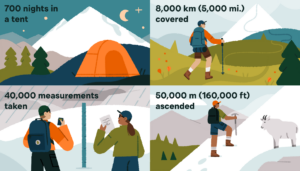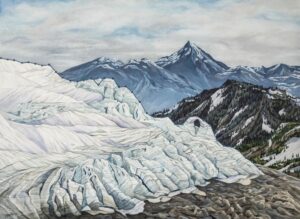
A few measures of what it takes to execute a field monitoring program of
glaciers for 40 years, with no helicopter support (Illustration by Megan Pelto).
North Cascade Glacier Climate Project 2024
41st Annual Field Program
Science Director: Mauri S. Pelto, mspelto@nichols.edu
Art Director: Jill Pelto, pelto.jill@gmail.com
2024 Field Season: For the 41st consecutive summer we are heading into the field to measure and communicate the impact of climate change on North Cascade glaciers. This year an overall focus of the project is observing, documenting and examining “What happens when a glacier disappears from the glacier to the sea?” We have three sponsors for the research this summer; Alpine Start (supplies), Heather’s Choice (supplies) and Protect Our Winters (grant funding).
This field season follows the 2021, 2022 and 2023 seasons that featured either historic heat waves and periods of extended warm weather. The heat led to a greater exposure of bare ice on glaciers with a higher albedo and greater density. The observed melt rates are 7-9 cm/day water equivalent during warm weather events vs 4-6 cm/day for snow surfaces. This led to substantial mass losses (glacier thinning) on North Cascade glacier for the three years of ~5 m. In 2024 winter snowpack in the North Cascades above 1200 m in 2024 was 60-75% of normal on May 1. May and June featured more new snow on the glaciers, mixed with periods of warm weather helped slow the loss of the limited snowpack above 1500 m.
Science objectives: We will complete detailed measurements on 10 glaciers, three of which are part of the World Glacier Monitoring Service reference glacier network (~45 glaciers globally), which have 30+ consecutive years of mass balance observations. This summer we will have an opportunity to assess the long-term ramifications of the 2021-2023 summers and measure the response of glaciers to the weather of 2024 with detailed mass balance, crevasse depths and glacier surface elevation profiling. We also focus on the impact of diminishing glacier size on downstream runoff. In four of our main field areas from 1984 we have observed a total of 25 glaciers disappear. In the Rainy Pass area, there are no longer glaciers for us to observe. See detailed observations.
Art Objectives: We will collaborate with several artists who will join us for a portion of the field season. They will be able to create their own work about the landscape and the science or may join us for fieldwork and make plans for future artwork. Artists include painters, a textile artist, illustrator, and an underwater photographer. We hope to use this art to share our research with a broader audience and highlight the beauty and importance of these places.
Communication Objectives: We will leverage the brands of our expedition sponsors this year which each have a climate change focus. These organizations can help spread our message. We will utilize a combination of artists and scientists to tell the story.
Field Team 2024:
Jill Pelto (she/her) is an artist and scientist from New England who grew up loving winter sports and trips to the mountains. She incorporates scientific research and data into paintings and prints to communicate environmental changes. Her multi-disciplinary work weaves visual narratives that reveal the reality of human impacts on this planet. She completed both her B.A. degrees in Studio Art and Earth and Climate Science, and her M.S. focused on studying the stability of the Antarctic Ice Sheet at the University of Maine, spending two field seasons at a remote camp in the southern Transantarctic Mountains. Jill will be joining the project for her 15th field season. She is excited about continuing to document the change in North Cascade glaciers that she has witnessed each of the last ten years — through science and art.
Mauri Pelto (he/him) has directed the project since its founding in 1984, spending more than 800 nights camped out adjacent to these glaciers. He is the United States representative to the World Glacier Monitoring Service. For 15 years he has been author of the blog “From a Glacier’s Perspective”, and associate editor for three science journals. He is on the Science Advisory Board for NASA’s Earth Observatory. His primary position is Associate Provost at Nichols College, where he has been a professor since 1989. He either runs on trails or skis on trails alpine and cross country every day.
Katie Hovind (she/her) is an undergraduate student at Western Washington University, majoring in Environmental Science, and exploring a range of minors from mathematics to Salish Sea studies. Born and raised next to the Cascades, she feels a deep connection to this region. Sailing, skiing, backpacking, and rock climbing have helped foster her love for the environment, and a determination to pursue a career studying and protecting it. As she starts mountaineering this year, she’s thrilled to combine that with glacier research. Having observed so much change in the mountains from afar, this is an amazing opportunity for her to gain hands-on experience and learn from the skilled scientists and artists collaborating to tell these glaciers’ stories.
Field Partners 2024-
Shari Macy (she/her) is a First Nations (Secwépemc) knowledge keeper, filmmaker, and underwater photographer. Feeling a strong ancestral duty to advocate for the health of our sacred lands and waters, she embarked upon a lifelong journey of dedication to creating impactful content that motivates, educates, and serves as a muse for change. From her award-winning nature documentary to scuba diving into Earth’s sacred bodies of water, she has an eye for the beauty that encompasses the planet we live upon. She is interested in observing changes in the glaciated waters of the Nooksack River and documenting those changes using underwater photography and film.
Emma Mary Murray (she/her) is an environmental artist focused on slow-crafting heirloom textile pieces that honor the landscapes they depict. She often up-cycles existing fabrics; her work combines her love of stitching and painting with her desire to work toward a more circular economy and a more sustainable future. When she is not moving her needle through canvas for hours upon hours, she explores the threads of connection between people and place by teaching at a place-based elementary school, teaching embroidery workshops for all ages, journaling outside, climbing, skiing, and trail romping. She hopes that by stitching the ever-changing light, topography, and textures of the North Cascades’ glaciers, she can spark greater appreciation for— and conservation of— the planet’s interconnected resources.
Karin Kirk (she/her) is a geologist, science journalist, and skier living in Bozeman, MT. She writes for Yale Climate Connections and NASA climate change. Karin is also a professional ski instructor at Bridger Bowl ski area and an avid backcountry skier. Her writing spans topics from Earth science to renewable energy data and often is centered around data-rich visualizations – always with the goal of explaining topics in a clear and relatable way. She regularly engages with policymakers and voters on matters of climate and energy, finding these interactions to be essential for developing her communications skills.
Ice Mermaid team: American ice swimmer Melissa Kegler, whose 2022 US record-breaking swim was documented in the film Ice Mermaid by Dan McComb, has set her sites on breaking the world record. But finding water cold enough for her to train and compete in year-around is becoming increasingly difficult. So this summer, we are teaming up to explore and swim in glacial lakes and to learn what disappearing glaciers could mean for the future of animals and humans downstream.
Claire Giordano is an environmental artist, writer, and educator creatively telling the stories of science, climate change, and the modern experience of nature. From creating rain-dappled sketches in an old growth forest to filming a watercolor class beside a glacier, careful observation of nature inspires her goal is to connect people and place through art. In 2021 she founded the Adventure Art Academy – a series of virtual watercolor classes filmed outside – to invite others into the joy of painting outside.
Charlie Weinstock (he/him) is an early-career scientist and geological consultant. He graduated in 2022 with a B.S. in Geology and a B.A. in Economics from the University of Massachusetts Amherst. His personal research focuses on understanding the formation of the Earth and other planetary bodies using integrated structural, geochemical, and mineralogical methods. He also recently passed his Fundamentals of Geology Exam and is now a licensed Geologist-in-Training (GIT) in California.

Painting by Jill Pelto that incorporates mass balance data from NCGCP from 1983-2022 along the top of the glacier.